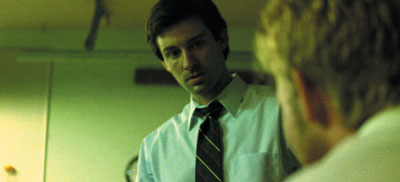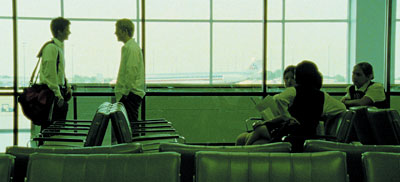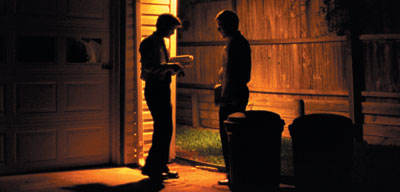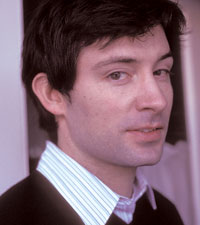TECH SUPPORT
The surprise winner of the 2004 Sundance Grand Jury Prize, Shane Carruth’s Primer is a cool and compelling sci-fi mystery astoundingly realized on an initial budget of only $7,000. Scott Macaulay unravels Primer’s secrets with Carruth.
 |
| Shane Carruth’s Primer, winner of the Grand Jury Prize at the 2004 Sundance Film Festival. |
After reading Geoff Gilmore’s Sundance catalog copy about Primer, in which he described the dialogue in Shane Carruth’s eerie and inventive sci-fi thriller as “borderline incomprehensible,” I knew I had to see this film. And for once my perverse tastes in festival film selection paid off. Not only did Carruth’s ability to create onscreen drama from the scientific dilemmas of our modern age immediately announce him as a major new voice in American independent cinema, but the film went on to win the Grand Jury Prize.
Primer is the story of a group of white-collar engineers who, moonlighting from their day job, embark in their garage on a scientific experiment that leads to wholly unexpected results. The film turns into something of a time travel movie, though not before pulling the viewer into the headspaces of its inventor heroes, fascinating us with the abstract calculus of their homemade experiments. I wish I could tell you more about the plot, but as Gilmore says, the dialogue is “borderline incomprehensible” — or at least it is to non–bio physics majors. No matter. As Carruth is quick to point out: “I love the science of this movie, and it actually makes a lot of sense. I went to a lot of trouble to make sure that the science works, but hopefully you at least get the sense that the characters understand the science of it.” In a dumbed-down world, Carruth’s smart bet on his audience’s intellectual curiosity bodes well for what could be a fascinating new American film career.
I spoke with Carruth at Sundance a few days before he won that Grand Jury Prize.
 |
Filmmaker: What inspired you to make this film?
Shane Carruth: When I started writing the script, I was reading a lot of nonfiction about the discovery of the transistor, calculus and the number zero. I found all these commonalities that I hadn’t seen play out on film. One of these is the fact that there’s this interesting side effect that often occurs [in scientific experiments] that [the scientists] dismiss because they don’t know what to do with it. And that [side effect] becomes the [most valuable discovery]. At the same time, I had this car wreck. I was laid up for a month, and I watched Turner Classic Movies at 3:00 in the morning every night. They showed all this amazing stuff from the ’70s like The Conversation, Norma Rae and All the President’s Men. I was amazed when I saw those films. Those [filmmakers] were asking the question: How do we deliver [information] in the most realistic manner? Even in bad movies from the ’70s, the actors were asking the right questions when they approached their characters. It was always about how real people would say those lines. I knew that the story I wanted to do was going to kind of go fantastical, but I also knew that I wanted it to be set in something really real. So that’s where it all came from.
Filmmaker: What did you do before the movie?
|
Filmmaker: When did you decide to become a filmmaker?
Carruth: It slowly dawned on me — I did not admit what I wanted early on. I’m 31, and I think I probably knew at 21 that there was something that I could put myself into. It just took a long time.
Filmmaker: How much did the film cost?
Carruth: The shooting budget was $7,000. Up until about a month and a half ago, that was the total budget. Once we found out it was in Sundance, we had to do a blowup, and that was several times the shooting budget. But the $7,000 doesn’t include the time I put into it, especially in post, doing foley work and looping in my apartment, and learning how to edit. It sounds silly, but if you imagine that my time was as valuable [as it was when I was software engineering], then yeah, the budget was a bunch more than $7,000.
Filmmaker: I don’t have a background in science, so a lot of the dialogue in the film went over my head. But I wondered how much of the dialogue and action would “track” if I knew a great deal about engineering.
 |
Filmmaker: Were you always planning to star in the movie?
Carruth: No. I tried out about a hundred different guys for the two lead roles, and from that process I found David Sullivan, who plays Abe. But [the casting process] was not easy. People would show up not prepared, and I would think, I don’t know if I want to trust a role to this person. Or a bigger problem was the fact that they would come from a drama background, and it was so difficult to explain to them the tone that we were going to do, that we were just going to play it straight and not imbue every line with drama. I would try to lead by example and soon found that I had memorized half the script! I figured, Well, I know I’m going to be there on the set and I’m one less person I have to call every day. Everyone in the film other than [David and myself] is either a family member, a friend or the actual person who works at that location. The biology lab guy is the real guy. The metal shop guy is the real guy.
Filmmaker: So you wrote, you directed, you produced and you acted. How did you wind up as director of photography?
Carruth: I didn’t know anything about cinematography, and I didn’t know enough to know that I probably didn’t need to learn, that I just needed to find a d.p. I did a lot of reading and found out that cinematography was really just photography with a set shutter speed. I bought some tungsten slide film, because I knew that motion picture film was mainly tungsten, and then I just storyboarded the entire script [by shooting slides] with light that I had available to me. The slides helped so much — once I had an image that I liked, I was pretty much set as long as there wasn’t some kind of anomaly in shooting motion pictures. And then I bought some fluorescent banks from Wal-Mart for, like, $23. It took a long time, but I just set up each shot exactly the way that I wanted it and took slides of them, so by the time we were shooting we knew exactly what f-stop to use. We were going for as narrow a depth of field as possible — 2.8 mostly. Even for daylight stuff, we’d throw a ton of neutral density on there to get a really narrow depth of field.
|
Carruth: It was really easy to do the math to convert it from one to the other. I think we mainly used 200T and then some 50D stuff for outdoor stuff. And then I was experimenting with 500T, which for Super 16mm was not the smartest thing for us to do. But there are a couple of shots in that film that used that stock.
Filmmaker: So the lighting that you used for the slide film storyboards you shot was the same lighting as the movie?
Carruth: Exactly. And it’s all available light. There was no light in the storage facility, so we would hang the fluorescents. But otherwise there was no lighting kit. I had seen some short student films, and I knew the lighting kit that they were using, and it worried me. I don’t know if it was because of the kit itself, but I don’t like that “key light, fill light” look. And so with my slides I was experimenting with everything. I used a lot of mixed lighting — fluorescents that would go blue or green, and tungsten that would go yellow. And then we even let the daylight come in and cast some blue in there if we wanted. I just didn’t want it to look like a student film.
Filmmaker: How big was your crew?
Carruth: Me plus five. Me, two camera operators and an assistant camera operator, James Russell, who was amazing. He was changing out mags the whole time because we shot a lot of short ends and really short rolls. Reggie Evans did the sound.
Filmmaker: One-person sound?
Carruth: Yeah, a guy with a DAT. I had gotten hold of some wireless microphones, but they were terrible and we never used them.
Filmmaker: So he did it the old one-handed boom, documentary style?
Carruth: Yes — he would just hit record. And David Sullivan, who plays Abe, also worked as a production assistant.
Filmmaker: How did you do the dolly shots with such a small crew?
 |
| Director Shane Carruth. |
Filmmaker: No art department?
Carruth: Just me and a couple of friends building stuff. People would come and take a look at what we were building in the garage, and they’d wind up [helping] by cutting PVC for half an hour or so.
Filmmaker: And the house?
Carruth: That’s my parents’ house and garage. Abe’s apartment is my brother’s apartment. Everything else is the actual location.
Filmmaker: What about editing? You cut the film as well — what did you cut on?
Carruth: I cut it on Adobe Premiere on a home system. I probably shouldn’t say anything negative, but it’s not something I would do again. It’s just not a program made for that at all.
Filmmaker: Did you match back to the film negative?
Carruth: Yeah — that’s one of the reasons that Premiere was not so great. I had transferred my Super 16mm negative to Mini DV for editing, but then for the print we needed to go back to the Super 16mm and blow it up to 35mm. I burned the timecode into my dailies, and I ended up having to hand-type a list of all the key frames where the cuts were. But what I didn’t know was that it’s a common practice now to do a digital intermediate. We got a pretty good price — it was actually cheaper than going the conventional optical route because I had a 2:1 shooting ratio. We could just scan everything, and I didn’t need a negative cutter.
Filmmaker: You basically eye-matched the frames?
Carruth: Basically. And then we conformed digitally and output to 35mm.
Filmmaker: What about doing the sound editing and mix?
Carruth: Premiere is not great for sound, so I had to use a lot of different programs. I used Sonic Boundary and Soundchords to clean stuff up.
Filmmaker: Did you have a filmmaking or producing mentor, or were you just basically learning this yourself?
Carruth: I learned it myself, and I’m glad. It wasn’t the smartest thing in the world, but it worked out okay.
Filmmaker: Did you ever go to film school?
Carruth: I audited a film course at SMU in Dallas for two weeks, but it quickly became a theory course about Faster, Pussycat! Kill! Kill and a bunch of John Waters films. It wasn’t so much my speed — I just wanted to learn the mechanics.
Filmmaker: And you didn’t even go to a nuts-and-bolts film class or anything?
Carruth: No, I just read some books and magazines.
Filmmaker: What books?
Carruth: Filmmaker’s Handbook. I read a lot of Filmmaker magazine.
Filmmaker: The film is quite relentless in its focus on the scientific drama. But in the movie the guy has got a wife and we see their child running around. There’s other stuff in his life than just this experiment, and obviously his focus on the experiment must be impacting his relationship with his family. Why did you decide not to focus on his personal life at all in the film?
Carruth: To be honest, I think that’s mainly because they say a feature-length film for festivals is about 72 minutes. I was basically dead set on meeting that, maybe going over a little bit, but not putting any more in there than I have to. When I’ve seen independent movies that I liked at the few festivals I have gone to, like South by Southwest, I always feel like they go on for too long. I would rather leave people wanting more.
Filmmaker: After you finished the film, what did you do? Just put it in an envelope and send it to Sundance?
Carruth: My whole concentration was Sundance, so I met the early submission. And to be honest, I got really paranoid once I sent it in. I didn’t know how much of [the selection] was political, and [the film] was just too much work — it took me two years just to edit it — to let it go by without anything coming of it. So I went out to Los Angeles and started making calls. One day I called publicists, and the next day agents and managers — anybody who I could get to take a look at it and hopefully get on my side. Out of all those hundreds of calls, I was able to get a few people to look at it. Mark Pogachevsky of mPRm saw something in it and made a call to William Morris, and they decided to rep the film. To be honest, I don’t know what good any of that did — Geoff Gilmore told me that it wasn’t a film that anybody had to lobby for.
Filmmaker Where do you live now?
Carruth In Dallas.
Filmmaker What’s next after this?
Carruth I have a script that I’m finishing now. I don’t honestly know the whole business side of it yet, but I’m hoping to make another film — hopefully on the strength of this one. We’ll see if it goes well.
VOD CALENDAR


 See the VOD Calendar →
See the VOD Calendar →


